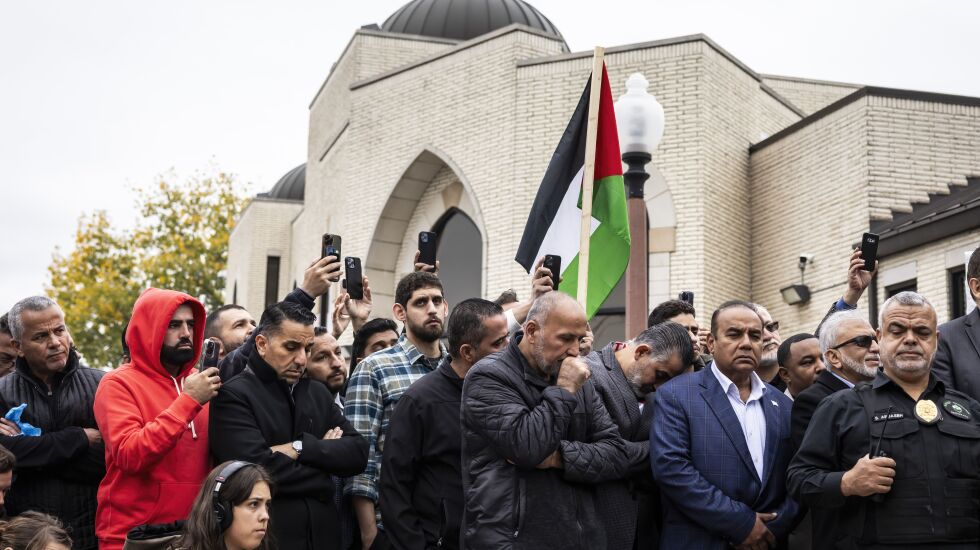
Layla Hedroug is a junior at Yale University on the East Coast. But while classes go on at the Ivy League school, she’s back home with her family in Chicago’s suburbs.
When the latest war broke out in Gaza, Hedroug, 20, started fearing for her safety as a Muslim woman who wears a hijab — perhaps the most visible representation of Islam at a time when anti-Arab hate and Islamophobia are on the rise.
“In this predominantly Arab Muslim community,” she said outside a mosque in south suburban Bridgeview, “I’ve never felt more unsafe than I do now. Even standing here, I don’t know what people’s intentions are.”
Hedroug wasn’t yet born in 2001, but for Muslims and Arab Americans who were, the past two weeks have brought dark memories of the hate they felt in the wake of the Sept. 11 attacks 22 years ago and the anguish of seeing neighbors and communities turn on them because of their religion.
Since the war started two weeks ago, two Chicago-area Muslim schools have received violent threats, a suburban man was charged with a hate crime for threatening to shoot two Muslim men and another suburban man allegedly told a woman, “Go back to your country.”
Many Muslim schools have been on soft lockdowns. And 6-year-old Palestinian American Wadea Al-Fayoume was killed in an alleged hate crime because of his ethnicity and Muslim faith, authorities said.
Sadia Nawab, a Pakistani American Muslim living in Chicago’s suburbs, was 12 at the time of the 9/11 attacks. And she remembers the hate well.
The same Mosque Foundation that held Wadea’s funeral services was targeted after the 9/11 attacks with violent threats, protests and police investigations, according to Nawab and news reports from the time. Two days after the attacks, a group of high schoolers marched toward the mosque after school let out in an “anti-Arab rally,” “shouting insults at passing cars occupied by people who appeared to be Arabic,” the Chicago Tribune reported at the time.
“We had someone slaughter a dog and put the dog’s head right by the doors of the mosque,” Nawab recalls. “We had our school windows broken. We had bomb threats. We had people with bats coming and driving through the neighborhood.”
Now 34, Nawab said her community is again taking precautions. Some are making sure to carry IDs in case they’re stopped by police. Others are locking their doors in neighborhoods they have otherwise felt safe in.
“We’re definitely a lot more cognizant,” she said. “Unfortunately, we’ve seen this before, 20 years ago, after 9/11. So we’re just preparing to make ourselves more safe.”
Like many, Nawab blames politicians and the media for advancing dangerous rhetoric and incomplete framing around the war in Gaza. News stories often leave out context about Israel’s 56-year occupation of Palestinian land, the 16-year blockade of Gaza and the West Bank, and what human rights groups have referred to as an apartheid government. Without that context, the public doesn’t sympathize with Palestinian suffering, Nawab said.
Politicians have also used the words “barbaric,” “savage” and “animals” to describe Palestinian militants, leaning on tropes used against Arab people. And media outlets have printed and aired similar views, including that pro-Palestinian protesters are “pro-Hamas” supporters.
That manifested at Yale with a student writing “Death to Palestine” on their dorm room door and calling Islam a “barbaric religion,” Hedroug said.
“I’ve had to lock my doors, carry pepper spray,” she said. “We walk in groups now. I fear for my hijabi sisters who are walking around the campus because we’re an even greater minority there.”
Hedroug has also heard professors repeat unverified claims about the war that have spread in American media.
So Hedroug came back to the Chicago area last week and attended Wadea’s funeral with her mother. They didn’t know the boy’s family but wanted to honor his life.
The 71-year-old man who fatally stabbed Wadea had started fearing for his safety after listening to conservative talk radio about Israel and Gaza, prosecutors said.
“The western media continues to perpetuate these harmful narratives and rhetoric that we have to pay the price for — our children have to pay the price for, as we’ve seen today,” Hedroug said. “Even though he’s so far removed from the conflict, he’s not overseas, he gets slaughtered at the hands of somebody taking these measures into their own hands, feeling entitled enough, emboldened by these narratives.”
Minna Hassaballa, 22, said many Muslims are trying to find support in community events, collective prayers and vigils.
“I worry more about the elders in our community,” Hassaballa said. “My grandparents, people who would be more susceptible to the more nefarious people who are actually looking to hurt them.”
Friends and family are warning each other to be safe while running errands like filling up gas or going to the grocery store. And news of hate crimes deepen that anxiety, she said.
Eman Abdelhadi, a University of Chicago assistant professor of sociology who has studied Muslim American life, said the language used by politicians and media to describe Arabs and Muslims and frame Palestinian life and Gaza often “translates into acts of violence.”
“When politicians use dehumanizing language to talk about Muslims and Arabs, it gives people permission to act on the notion that we aren’t human beings,” Abdelhadi said.
“The cumulative effect of all of these actions is to put people on high alert and make you feel like you don’t belong in this society, you’re this unwanted outsider.”
Abdelhadi said anti-Arab and Islamophobic sentiments are “deeply rooted” in American culture. And while it might fade into the background sometimes, “it comes back with a vengeance” as soon as Muslims are in the news.
“People understood it didn’t go away but thought we made significant progress,” she said. “And this feels like a 20-year regression in the narratives about Muslims and Arabs.”







